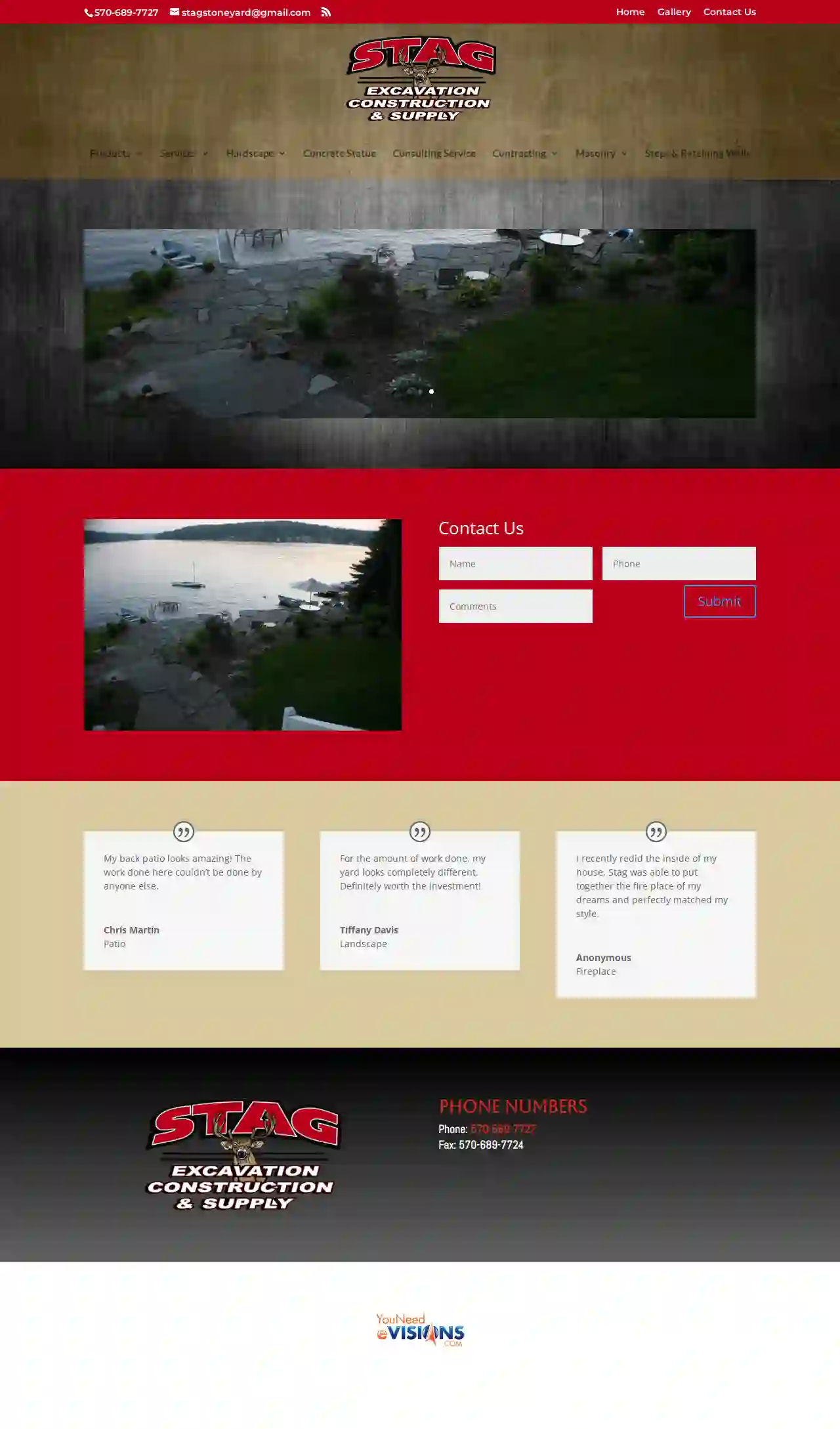Excavation Contractors Lower Pottsgrove
Top 10 Digging Contractors in Lower Pottsgrove
Receive up to 3 Excavation Contractors Near Me quotes for your project today! Compare profiles, reviews, accreditations, portfolio, etc... and choose the best offer.

William Lawrence Excavating & Trucking
4.36 reviewsScranton, USAbout William Lawrence Excavating & Trucking William Lawrence Excavating and Trucking Company is a locally owned and operated business serving both residential and commercial clients in Montrose, PA for over 35 years. We take pride in our modern and well-maintained equipment, operated by a qualified, courteous, and reliable crew. Our commitment to safety is reflected in our fully insured operations. Whether you're planning a large or small project that requires excavating or trucking services, we offer free assistance in the planning stage and a free evaluation to help you find the most cost-effective methods available. We believe in delivering exceptional service and ensuring your project is completed to the highest standards. At William Lawrence Excavating & Trucking, we stand by our motto: "If We Start It…We Complete It!"
- Services
- Why Us?
- Gallery
Get Quote
Stag Excavation Construction & Supply
52 reviewsHamlin, USStag Excavation & Stone Yard Stag Excavation & Stone Yard is a family-owned and operated business serving the Hamlin, PA area. We offer a wide range of services, from excavating and demolition to hardscaping and custom home construction. We are committed to providing our clients with high-quality workmanship and exceptional customer service. Our team of experienced professionals is dedicated to exceeding your expectations and delivering projects on time and within budget. We are proud to be a trusted name in the community and look forward to serving your needs. We are located just outside of Hamlin Corners in Hamlin PA. We offer free estimates on all of our services. Contact us today to schedule a consultation.
- Services
- Why Us?
- Testimonials
- Gallery
Get Quote
Rock Solid Landscaping and Masonry Design, Inc
3.723 reviews516 Industrial Loop, Staten Island, 10309, USAward winning landscape design & build since 1998 Full Service Landscape Architects Award winning landscape design & build since 1998 Full Service Landscape Architects Award winning landscape design & build since 1998 Full Service Landscape Architects Rock Solid Landscape and Masonry Design Inc specializes in designing and creating your dream home. Being experts in both hardscape and landscape design in Staten Island, we will help build the concept from your vision and ideas, and bring them to life. From start to finish, we work together with each of our clients to ensure that the work that is being done matches the concept that they dreamed up. Let Rock Solid Landscape and Masonry Design Inc create your next landscape masterpiece. Rock Solid Yards is the winner of Two 2010 Staten Island Chamber of Commerce Building Awards for: ROCK SOLID LANDSCAPE AND MASONRY DESIGN INC. more about us Serving the Tri-State area since 1998. MICHAEL IZZO OWNER/MASTER DESIGNER Michael Izzo has over 20 years of Landscape and Masonry Construction experience. He built Rock Solid Landscape and Masonry Design, Inc. from the ground up and he attributes his success to practicing good old fashioned business ethics and promoting a company philosophy of “exceeding customer expectations”. “Customers will return to and promote a business that consistently shows up and delivers exceptional quality projects on schedule and on budget. It’s really that simple.” Trust us for your masonry design and landscaping in Staten Island
- Services
- Why Us?
- Our Team
- Testimonials
- Gallery
Get Quote
Charlie Nansteel Tree and Excavation LLC
4.230 reviewsBangor, USTransforming Landscapes, Enhancing Lives Discover unparalleled tree services in Bangor, PA, with Charlie Nansteel Tree & Excavation, LLC. Offering safety, beauty, and peace of mind with every project, we're dedicated to transforming your outdoor spaces into magnificent landscapes. Premium Tree Services in Bangor, PA, and the Lehigh Valley Area Quality We use top-of-the-line equipment to ensure the highest quality of service. Expertise Our team’s decade of experience sets us apart in providing reliable solutions. Safety Safety is paramount, guiding every project from start to finish. Customer Satisfaction We’re committed to exceeding expectations, ensuring every client is thrilled with the outcome. Your Ultimate Solution for Tree-Related Challenges Dealing with tree-related issues can often be stressful and inconvenient, impacting your daily life and the safety of your property. In Bangor, PA, and the Lehigh Valley area, Charlie Nansteel Tree & Excavation, LLC stands as a beacon of relief for those facing such frustrations. With top-of-the-line equipment and a team of highly experienced professionals, we offer unmatched services that address all your tree needs. Our array of services includes efficient tree removal, precise tree trimming, comprehensive lot clearing, expert excavating, and bespoke commercial landscaping. Each service is delivered with the aim to transform your space, ensuring your environment is safe, functional, and aesthetically pleasing. Let us take the hassle out of tree services, offering you peace of mind and satisfaction. Reach Out Make the Right Choice for Your Property Today! Looking for tree services in Bangor, PA? Charlie Nansteel Tree & Excavation, LLC is your go-to provider. With over 10 years of experience and a dedication to excellence, we cater to both residential and commercial clients. Our unique combination of state-of-the-art equipment and seasoned expertise ensures every project is a success. Embrace the difference with our free estimates and see how we can transform your space into something extraordinary. Don’t wait; enhance your property’s safety and beauty today!
- Services
- Why Us?
- Gallery
Get Quote
Ironstone Excavating
4.58 reviews2551 Mill Road, Elizabethtown, 17022, USIronstone Excavating: Your Premier Excavation Company Ironstone Excavating is your one-stop excavating service company, proudly serving Lancaster, Dauphin, York, Lebanon Counties, and beyond. We understand the importance of a strong foundation for any structure, and we're committed to providing the highest quality excavation services to ensure your project is built to last. We offer a wide range of services, including: Excavation for residential, commercial, and agricultural projects Utility line installation and replacement Demolition services for fire damage and other property issues Septic system installation and maintenance Our team of experienced professionals is dedicated to providing exceptional service and ensuring your satisfaction. We use the latest equipment and techniques to complete your project on time and within budget. Contact us today for a free estimate and let us help you build a solid foundation for your future.
- Services
- Why Us?
- Testimonials
- Gallery
Get Quote
CAG Construction Corporation
1540 Castleton Ave., Staten Island, USCAG CONSTRUCTION CORP. CONSTRUCTION DONE RIGHT Our experience ensures that your projects will be completed within budget, on time and with the upmost professionalism. LEARN MORE Family Run and Operated Construction Company Since 2007
- Services
- Why Us?
- Gallery
Get Quote
I & I Excavating Inc.
57 reviewsNiagara, USHistory Welcome to I and I Excavating Inc, your premier destination for exceptional excavation and concrete services. Boasting over three decades of industry experience, our skilled team of professionals is devoted to delivering top-notch solutions tailored to your concrete needs. Catering to both homeowners and business owners, our comprehensive suite of services includes concrete driveways, sidewalks, patios, and innovative drainage solutions. At I and I Excavating Inc, we distinguish ourselves by consistently delivering outstanding results for every project we undertake. We invest the time to thoroughly comprehend your objectives and aspirations, collaborating closely with you to craft a bespoke solution that aligns with your distinct specifications. Our meticulous attention to detail and unwavering commitment to quality differentiate us from our competitors, and we assure your utmost satisfaction with the final outcome. So, what makes I and I Excavating Inc the ideal choice for your upcoming project? Our team of seasoned experts is dedicated to providing dependable, efficient, and cost-effective services. We utilize only the best materials, taking immense pride in our craftsmanship. Furthermore, our steadfast commitment to exceptional customer service ensures that we are always available to address your queries and concerns. Choose I and I Excavating Inc for a seamless and satisfying experience that exceeds expectations.
- Services
- Why Us?
- Testimonials
- Gallery
Get Quote
Weaver & Sons Excavation
55 reviews5147 Ore Bank Road East, York, 17406, USThe clear choice for all your excavation needs. These are our original pieces of equipment. While we have greatly expanded our fleet to address our clients' needs, our motto is still the same: "We want the small jobs the big guys don't want." SERVICES With over 30 years of experience in excavation and general construction, we can help you design a solution that meets your needs at a very reasonable cost. ABOUT Weaver and Sons Excavation started in 2007 when Mark Weaver closed his general construction business after 20 years. He decided to keep his excavation equipment and continue on as a part-time business. Eventually, business was good enough that he decided to go full-time. After going full-time, the Weaver and Sons office was relocated to a 200-year-old town hall building in Wrightsville that Mark personally renovated. We have since added a new shop and office in Hellam, York County. Mark's experience of over 30+ in the general construction business gives him the unique ability to advise on all phases of your project, as well as the excavation phase. Weaver and Sons can provide references from past residential clients, as well as numerous commercial contractors that use them regularly. Our mission is simple: Get in, get out, and leave a happy customer!
- Services
- Why Us?
- Our Team
- Gallery
Get Quote
Kizer Landscaping & Excavating
4.897 reviewsGreentown, USExperience the Difference Kizer Landscaping and Excavation No matter how big or small your landscaping job is, Kizer Landscaping & Excavating is here for you! We give you the best value, the best service, and you can depend on us to get the job done right. We are a locally owned and operated business based in Greentown, Pennsylvania. About Explore our Services Kizer Landscaping and Excavation We offer a variety of services, including landscaping, topsoil, stump removal, gravel driveway installation and repair, as well as many hardscaping services to enhance the look of your outdoor space and increase your home's value! Kizer Landscaping & Excavating also provides maintenance services for residential & commercial properties, on either a 7-day or 14-day cycle. Learn our History Kizer Landscaping and Excavating was founded in 2008 by Craig Kizer in Pike County. At age 8, Craig mowed his first lawn, and in the years that followed he developed a greater attention to detail for both lawn care and landscaping work. Turning his love and passion for the outdoors into a career was a natural step for Craig, seen today in the value and quality of his company’s work. Meet Craig and His Team >
- Services
- Why Us?
- Testimonials
- Gallery
Get Quote
Diggerman Excavating
819 Lake Henry Rd., Lake Ariel, 18436, USLooking for a rock and excavation specialist? You've come to the right place! With extreme attention to detail and a passion for excavating, the Diggerman is the man you need for your project!
- Services
- Why Us?
- Gallery
Get Quote
Over 22,076+ Excavation Contractors on our directory
Our excavation companies operate in Lower Pottsgrove and surrounding areas!
ExcavationHQ has curated and vetted Top Excavation Pros in Lower Pottsgrove. Find the most reliable contractor today.
Frequently Asked Questions About Excavation Contractors
- Spring and Fall: Often considered favorable due to moderate temperatures and drier soil conditions.
- Summer: Can be suitable, but hot weather can make working conditions challenging and might require additional measures (shade, hydration) for workers.
- Winter: Excavation in winter can be more difficult due to frozen ground, snow, and potential delays caused by inclement weather. It might also require specialized equipment or techniques.
- Utility Locates: Contact your utility companies to mark the locations of underground lines before excavation begins. This is usually a free service.
- Hand Digging: Excavate carefully by hand near marked utility lines to avoid damage.
- Potholing: Digging small test holes to expose and verify utility depths and locations.
- Safe Distances: Maintaining a safe distance between excavation equipment and marked utility lines.
- Vacuum Excavation: Using vacuum excavation techniques to expose utilities without digging, reducing the risk of damage.
- Topsoil Removal: Stripping the fertile topsoil layer from a site, often preserving it for landscaping.
- Trench Excavation: Digging long, narrow trenches for utilities (pipes, cables) or foundations.
- Basement Excavation: Removing earth to create a space for a basement beneath a structure.
- Pool Excavation: Digging a precise hole for installing a swimming pool.
- Roadway Excavation: Removing earth and preparing the ground for road construction.
- Demolition Excavation: Clearing debris and preparing the site after demolition.
- Channel Excavation: Creating channels for drainage or irrigation.
What is the best time of year for excavation?
How do you protect utilities during excavation?
What are the different types of excavation?
What is the difference between cut and fill excavation?
Cut: Involves excavating soil from an area where the existing grade is higher than the desired grade.
Fill: Refers to using the excavated soil ('cut' material) to raise the grade in an area where the existing grade is lower than desired.
This method minimizes the need to import or export soil, reducing costs and environmental impact. It's commonly used for site preparation, road construction, and landscaping.
What is the best time of year for excavation?
- Spring and Fall: Often considered favorable due to moderate temperatures and drier soil conditions.
- Summer: Can be suitable, but hot weather can make working conditions challenging and might require additional measures (shade, hydration) for workers.
- Winter: Excavation in winter can be more difficult due to frozen ground, snow, and potential delays caused by inclement weather. It might also require specialized equipment or techniques.
How do you protect utilities during excavation?
- Utility Locates: Contact your utility companies to mark the locations of underground lines before excavation begins. This is usually a free service.
- Hand Digging: Excavate carefully by hand near marked utility lines to avoid damage.
- Potholing: Digging small test holes to expose and verify utility depths and locations.
- Safe Distances: Maintaining a safe distance between excavation equipment and marked utility lines.
- Vacuum Excavation: Using vacuum excavation techniques to expose utilities without digging, reducing the risk of damage.
What are the different types of excavation?
- Topsoil Removal: Stripping the fertile topsoil layer from a site, often preserving it for landscaping.
- Trench Excavation: Digging long, narrow trenches for utilities (pipes, cables) or foundations.
- Basement Excavation: Removing earth to create a space for a basement beneath a structure.
- Pool Excavation: Digging a precise hole for installing a swimming pool.
- Roadway Excavation: Removing earth and preparing the ground for road construction.
- Demolition Excavation: Clearing debris and preparing the site after demolition.
- Channel Excavation: Creating channels for drainage or irrigation.
What is the difference between cut and fill excavation?
Cut: Involves excavating soil from an area where the existing grade is higher than the desired grade.
Fill: Refers to using the excavated soil ('cut' material) to raise the grade in an area where the existing grade is lower than desired.
This method minimizes the need to import or export soil, reducing costs and environmental impact. It's commonly used for site preparation, road construction, and landscaping.